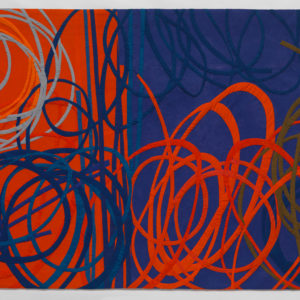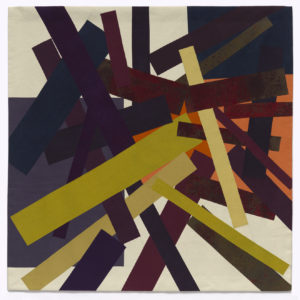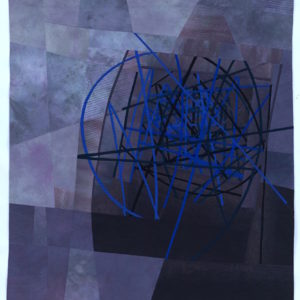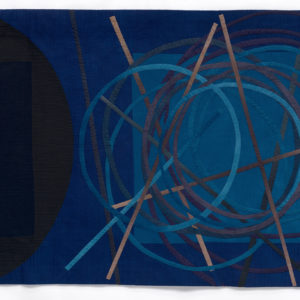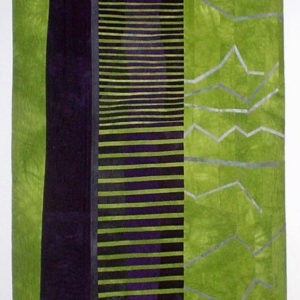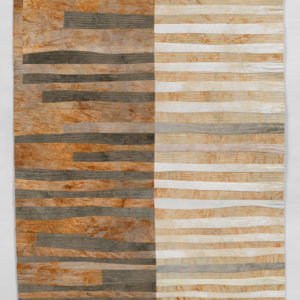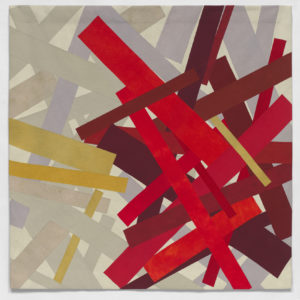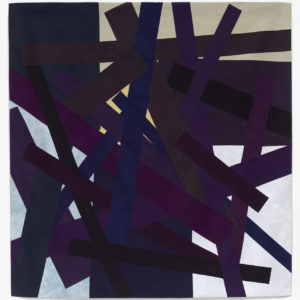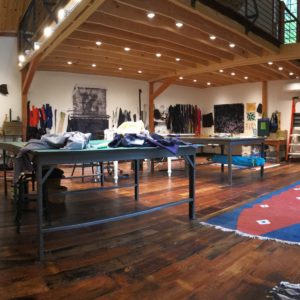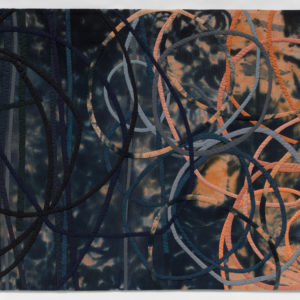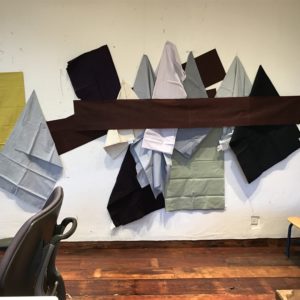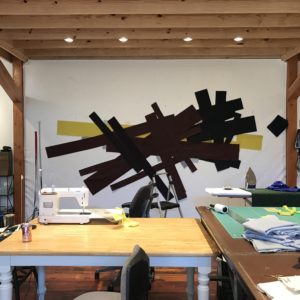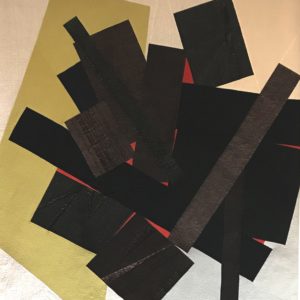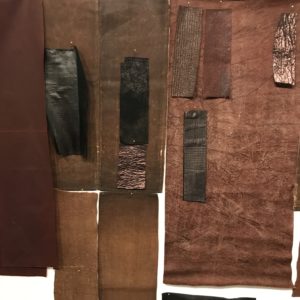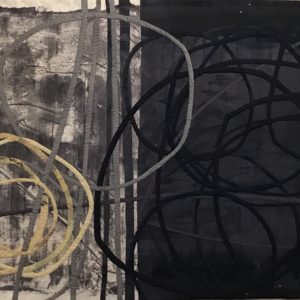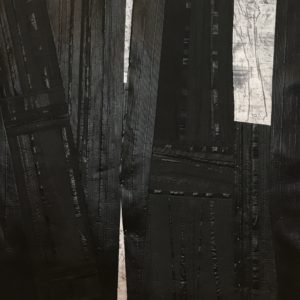Intervista con Judy Kirpich
Judy Kirpich è una nota e apprezzata artista tessile, le sue trapunte sono state esposte in musei e mostre di arte tessile in Asia, Stati Uniti, Sud America ed Europa. Ha ricevuto il prestigioso Quilt National Japan Prize e si è unita ad un gruppo di artisti che hanno mostrato il loro lavoro in Mastery: SustainingMomentum, e Color Improvisations 2, due mostre curate da Nancy Crow. I suoi quilt della “Conflict Series” sono state esposte in una mostra personale alla Aughinbaugh Gallery nel 2017. In questo momento, Judy si sta preparando per una mostra personale nel 2019. Questo è il link al suo sito web:
Judy perché hai scelto di utilizzare il tessuto come mezzo per la tua arte?
Amo l’odore della stoffa, le sensazioni che mi dà e la sua consistenza. Non c’è niente di più bello che passare ore in giro per i negozi di New York a caccia di tessuti insoliti. Quando viaggio all’estero sono sempre incuriosita dai diversi tessuti che trovo e mi interessano tanto le sete pregiate quanto la canapa vintage. Mentre lavoro principalmente con i cotoni, mi piace combinare i tessuti che ho trovato in Giappone e in Cina con quelli che ho a disposizione qui. Negli ultimi dieci anni ho lavorato con cotoni tinti su misura, e ho una fonte meravigliosa che tinge per me i tessuti secondo le mie specifiche indicazioni. Anche se ho fatto qualche corso, preferisco passare il mio tempo a disegnare e cucire piuttosto che a tingere i tessuti.
Puoi dirci qualcosa di te stessa e della tua storia di artista? Come hai iniziato?
Sono sempre stata coinvolta nell’arte sia come studente che come proprietaria di una grande agenzia di graphic design. I miei primi ricordi includono lezioni d’arte a partire dai 4 anni. Crescendo ero circondata dall’arte; mia madre era una ceramista che ha insegnato e sperimentato le tecniche primitive di cottura della ceramica, e mio padre lavorava come ingegnere, ma passava tutto il suo tempo libero a lavorare il legno. La casa dei miei genitori era piena di ceramiche di mia madre e i mobili di mio padre e gli eventi del fine settimana includevano frequenti viaggi nei musei di Philadelphia.
Fin da giovanissima mia zia Nomi mi portava a fare shopping in un bellissimo negozio di tessuti a Philadelphia. Cuciva tutti i suoi vestiti e ha insegnato anche a me. Quando sono invecchiata ho iniziato a realizzare i miei vestiti autonomamente. Mi sono innamorata dei vestiti di IsseyMiyake ma da giovane professionista e madre con due figli piccoli, non avevo i soldi per acquistarli. Mi sono unita ad un gruppo di donne a Washington DC e studiavamoe scambiavamo i suoi modelli. Da quel momento in poi ho cucito da me tutto il mio abbigliamento.
Fino a circa 15 anni fa non facevo quilt o arte tessile, solo occasionalmente, realizzavo coperte da letto. A un certo punto mi sono ritrovata con troppi vestiti e con il bisogno di avere un modo diverso di esprimere il mio amore per il tessuto. Mi è capitato di sfogliare una vecchia copia della rivista Threads e trovare un articolo su Nancy Crow… da quel momento in poi la mia vita è cambiata.
Può parlarci dell’inizio e dello sviluppo di una delle tue opere? Come nasce un nuovo lavoro?
Sono motivata dalle emozioni, dagli eventi che mi circondano, personali e politici. Non realizzo quasi mai un’opera che non rappresenta come mi sento in un particolare momento della mia vita. Per esempio, la serie Anxiety è nata dallo stress che avevo come capo di una grande azienda di 35 persone durante la Grande Recessione per cercare di far quadrare i conti: la mia serie Conflict è iniziata con mio marito, uno studioso del Medio Oriente, durante le discussioni sulla guerra in Siria. Memory Loss è influenzata dal lento declino di mia madre a causadell’Alzheimer.
Spesso utilizzo una tecnica che mi permette di liberare alcune di queste emozioni. Ho iniziato la mia serie Anxiety tagliando continuamente il tessuto. Ero così nervoso e ansioso ed è stato un modo meraviglioso per sciogliere la mia tensione.
Non faccio schizzi e raramente uso il computer per comporre un pezzo. Invece faccio molte fotografie, passo del tempo a guardare l’arte e uso Pinterest come un moderno quaderno degli schizzi. Lavoro improvvisamente tagliando i tessuti a mano libera e appuntandoli in una composizione. Trascorrerò giorni, a volte settimane per ottenere una composizione esattamente come la voglio. Non inizio a cucire fino a quando non sono soddisfatto al 100% della composizione.
Vorrei poter costruire pezzi con l’obiettivo di fare semplicemente qualcosa di bello, senza sottotesto. Ma la verità è che trovo la maggior parte di quei pezzi insipidi. Senza emozione trovo i miei pezzi vuoti.
Come si è evoluto nel tempo il tuo stile compositivo? Hai sempre realizzato opere astratte? Quali sono le differenze tra i tuoi primi lavori e quelli più recenti?
I miei primi quilt non da letto eranofigurativi. Ho fatto una serie sulle sedie (chi non l’ha fatto?!) e poi ho cucito una serie sui pettini. La mia serie Cancer Comb è iniziata come rappresentazione –un lavoro figurativo alto 7′ del pettine nero usato da mio padre, e si è trasformato in un lavoro più astratto a partire dal terzo di quella serie.
Dopo Comb Series non mi sono mai guardata indietro e ho lavorato solo con composizioni astratte.
Ironia della sorte, sia i miei primi lavori che quelli più recenti hanno a che fare con i miei genitori. La serie Cancer Comb segue la battaglia di mio padre contro il cancro ai polmoni e i miei pezzi più recenti della serie Memory Loss trattano della demenza di mia madre. Il primo era figurativo: l’ultimo è astratto.
Judy, hai frequentato molti dei corsi di Nancy Crow. Che ruolo ha avuto questa esperienza nel tuo modo di “fare arte tessile”?
Mi sento molto privilegiato ad avere Nancy come mentore. Quando ho frequentato per la prima volta i suoi corsi non avevo idea di quello che stavo facendo – sapevo solo che non avevo la pazienza o l’interesse per il quilting convenzionale. Quando ho visto il lavoro di Nancy – il primo pezzo che ho visto è stata la sua interpretazione di un log cabinquilt – sapevo di aver trovato lo sbocco per il mio amore di sempre per l’arte tessile.
Nancy parte da zero e insegna i fondamenti del design, le relazioni figura/terra, la teoria del colore e la composizione. Lei è un’insegnante esigente e dura che apprezza il duro lavoro e spinge ciascuno dei suoi studenti a eccellere. Non è per tutti, e certamente non per una quilter che vuole solo dilettarsi in varie tecniche. Spinge i suoi studenti a trovare la propria voce e non accetta le imitazioni di Nancy Crow. Questo stile si adattava alla mia personalità – e non ho mai lavorato così duramente – iniziando le mie giornate alle 7 del mattino e terminando alle 23:00 – 7 giorni alla settimana. Anche ora la mia pratica in studio è abbastanza rigorosa. Sono nel mio studio la maggior parte dei giorni alle 8 e lavoro fino alle 5 o 6 con una pausa pranzo di mezz’ora. Lavoro ancora 6 o 7 giorni alla settimana.
Devo ammettere che a tutt’oggi, quando un mio pezzo viene ammesso in una mostra, mi chiedo ancora cosa ne penserà Nancy. La sua approvazione è ancora il mio “gold standard”.
Forse la più istruttiva delle classi di Nancy erano i suoi master class dove gli studenti erano designer molto avanzati. Piuttosto che insegnare le tecniche abbiamo passato molto del nostro tempo confrontandoci. Abbiamo parlato del ruolo dei tessuti nel mondo dell’arte. Abbiamo discusso di questioni più ampie piuttosto che di tecniche di costruzione. Abbiamo guardato e discusso il lavoro di artisti contemporanei come Agnes Martin e Richard Diebenkorn. Ascoltare le voci di 20 artisti tessili ben considerati è stata un’esperienza incredibile che ha formato gran parte del mio pensiero.
Puoi spiegarci le motivazioni stilistiche e artistiche che ti portano a lavorare in serie?
Se si studia il lavoro di Cezanne, troverete nel suo catalogo ragionato molti disegni e dipinti di pesche e pere. Mentre la maggior parte delle persone conoscono solo alcune delle sue nature morte di frutta. Ha usato lo stesso soggetto più e più volte, provando nuove tecniche, colori, angoli e composizioni.
Come Cezanne lavoro in serie perché ogni pezzo è il punto di partenza del prossimo. Nelle lezioni mostro spesso il mio primo pezzo e l’ultimo pezzo di una serie. La differenza è stupefacente. Se mi fossi fermato dopo Quilt No. 1, non avrei mai perfezionato le mie composizioni. Non devo mettere tutti i miei pensieri in una singola trapunta, ma piuttosto posso sperimentare attraverso una serie. Un altro vantaggio è che lavorare in serie significa anche che non devo costantemente pensare a nuovi soggetti.
Lavori su più serie contemporaneamente, o ti dedichi ad una alla volta?
Di solito lavoro su due o tre serie contemporaneamente. Ora ho uno studio abbastanza grande da poter lavorare contemporaneamente su pezzi diversi e questo mi permette di dedicare a ciascuno di essi la giusta attenzione. A volte, dopo qualche anno, torno a una serie, cambiando lo stile e la tavolozza dei colori. Attualmente sto lavorando su pezzi delle serie The Day After, IndigoCompositions e Memory Loss. L’unica serie che è “chiusa” è la serie Cancer Comb. Dopo la morte di mio padre ho finito un ultimo pezzo che rispecchiava il primo pezzo. Ho deciso di non lavorare di nuovo su quella serie.
C’è un gruppo di lavori che ti rappresenta di più, che ha giocato un ruolo rilevante nella tua crescita come artista?
Penso che la serie Anxiety sia la più personale del mio lavoro. In questa serie ho lavorato sulle tensioni derivanti dalla gestione di un’azienda, dal licenziamento di un amico, dall’affrontare la mastectomia di una persona cara, dalla battaglia di un membro della famiglia con la depressione e dall’equilibrio di emozioni contrastanti al momento del mio pensionamento. Continuo a tornare alla serie Anxiety quando ho problemi personali da risolvere.
Attualmente il mio lavoro nella serie Memory Loss è l’unico modo per esprimere il dolore che provo per la perdita cognitiva di mia madre. Con questi pezzi uso tessuti con più superfici, trapuntatura a mano e ricamo. Sento che questo mi sta portando in un nuovo viaggio, ma non sono sicura di dove porterà.
Le tue opere d’arte sono sempre di grandi dimensioni. Quali sono le ragioni tecniche o stilistiche che ti portano a lavorare su superfici così importanti?
Penso che la dimensione abbia molto a che fare con il modo in cui un pezzo viene visto. Voglio che i miei pezzi siano visti come arte, non come trapunte e non come artigianato. Quando penso agli artisti che mi hanno influenzato – Pierre Soulanges, CyTwombly, CyTwombly, Franz Kline, Louise Nevelson – tutti hanno lavorato in grande, e penso che la dimensione sia parte del potere della loro arte. Inoltre, Nancy Crow mi ha sempre spinto a lavorare sempre più grande.
Lavorare con queste dimensioni comporta una serie di sforzi fisici. Mi trovo a salire e scendere per tutto il tempo dalla scala, cosa che andava bene quando avevo 50 anni ed è un po’ più difficile adesso che ne ho60. Sollevare costruzioni pesanti, alte oltre 80″ e talvolta larghe fino a 120″, è difficile per le mie spalle, e girare il materiale per trapuntarlo ha portato ad alcuni strappi alla cuffia dei rotatori. Mi ritrovo a ridurre le dimensioni dei pezzi a 60″, perché sono più maneggevoli. Preferisco ancora lavorare io stesso i pezzi trapuntati su una macchina da cucire convenzionale – non una long arm, e questo è fisicamente più impegnativo. Ma sono ancora determinata a lavorare il sulle grandi dimensioni.
Quanto è importante per te la scelta dei materiali? Ti piace sperimentare con materiali insoliti? Puoi parlare dei tessuti della serie IndigoCompositions?
Non direi che amo particolarmente sperimentare, ma ho alcune fonti inusuali per alcuni dei tessuti con cui sto lavorando.
Ho scorte di meraviglioso indaco vintage giapponese e tessuto tinto con il succo dei cachi (kakishibu) che ha fatto il suo ingresso in alcuni dei miei pezzi. Ho dei bei tessuti che prima erano “sakebags”.
Ho lavorato e giocato con un cotone indaco prodotto da un gruppo etnico in Cina. Gli abitanti del villaggio girano il panno, lo tingono con coloranti indaco naturale, e dopo che il tessuto si asciuga tingono il panno con una miscela di sangue di bue e peperoni. Terminano un lato del tessuto spalmandolo con un uovo e battendo il panno. Il risultato è che un lato è un nero o marrone molto lucido, mentre l’altro lato è un nero opaco o marrone. Ho sperimentato l’uso diquesta stoffa per oltre 3 anni e sto iniziando a capire in che modo voglio utilizzarla. Ha una notevole capacità di mantenere una forma, tenere una piega e non si sfilaccia. Ho completato molti piccoli studi e ora sono pronto a lavorare su una superficie più ampia.
A cosa stai lavorando al momento? Vuoi parlarci dei tuoi progetti attuali?
I miei ultimi lavori riguardano la collaborazione con due artisti. JayneWilloughby, una nota artista che crea alcuni degli sfondi dipinti per i top che sto usando attualmente. Annette Wink è la persona che tinge le mie stoffe e con cui ho lavorato per 10 anni, e mi fornisce anche un diverso tipo di tessuto a disegno. Entrambi gli artisti hanno stili molto diversi e sto iniziando a combinare i tessuti di entrambi nelle mie composizioni. Questo è un grande punto di partenza per me, dato che ho sempre lavorato con i cotoni tinti in massa.
Sto finendo un pezzo su cui ho lavorato per due anni e che fa parte della serie The Day After. Sto anche lavorando per una mostra che si terrà nell’ottobre 2019 dove vorrei avere almeno 6-8 pezzi della serie Memory Loss. Finora ne ho completati cinque, quindi ho un sacco di lavoro da fare! Probabilmente posso finire da 5-7 pezzi all’anno a seconda delle loro dimensioni e complessità ed è molto facile per me distrarmi con nuove idee.

